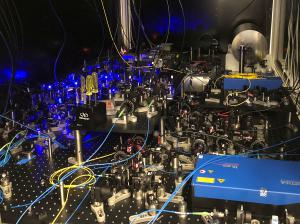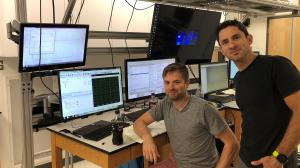AWG-card by Spectrum used to move around single atoms
Extraordinary precision in the pioneering research of the second Quantum Revolution
To manipulate individual atoms, you need extraordinary precision to deliver exactly the right amount of energy from each laser pulse.”
GROSSHANSDORF, GERMANY, October 14, 2020 /EINPresswire.com/ -- How do you determine what is going on when you can’t actually see the components in the system you are investigating? This is the challenge when investigating the quantum behavior of electrons in a lattice of ions. The solution being created by the Physics Department at the University of San Diego, California is to build a model that is slightly larger with observable components of atoms moving in an optical lattice. The challenge is to cool the atoms to near absolute zero and then move them into a triangular lattice formation using pulses of laser light, which have to be ultra-precise, with virtually no noise in the control signal for the laser beams. To achieve this, a Spectrum Instrumentation M4i.6622-x8 Arbitrary Waveform Generator is used. — Dr. Julio Barreiro
Dr. Julio Barreiro, the Assistant Professor in charge of the research, explained: “To manipulate individual atoms, you need extraordinary precision to deliver exactly the right amount of energy from each laser pulse. I heard about the precision of Spectrum AWGs from a colleague at CalTech who is using one to move individual atoms in his research and recommended them. Its extreme precision and lack of noise is exactly what we need, otherwise atoms would not go where we want them and, worse, any signal noise would heat up the atoms.”
The first step is to cool a few million strontium atoms to within a few hundred nano-degrees of absolute zero in a vacuum chamber. The next step is to move the ultra-cold atoms into a flat sheet like a pancake again using laser pulses. Then, three lasers that are arranged in a plane at 120 degrees from each other, are fired in turn to propel the atoms into synchronized triangle patterns. These dancing atoms are simulating the quantum behavior of electrons in a lattice of ions. “This gives us a model of quantum behavior that we can observe with ultra-sensitive cameras as we subject it to changing conditions to see how our predicted result from computer modelling compares with reality,” added Dr. Barreiro, “which is something that you just cannot do at the electron level.” For a size comparison, this modeling is working at 500nm sizes, whereas the electrons in a lattice is at the level of Angstroms. The precise and coordinated dance of the atoms in a triangular lattice is enabled by multiple triplets of laser light frequencies controlled by the Spectrum AWG using its multi-channel outputs.
The applications of this Blue-Sky basic research, which forms part of the second Quantum Revolution, include studying the quantum effects in materials for quantum computers and molecular structures for quantum chemistry that could be used to create novel medicines.
Dr. Barreiro concluded: “Not only was the Spectrum AWG unbeatable on the quality of its output but it was also unbeatable on price. We looked at rival card solutions and they came nowhere near on the precision and ultra-low noise that we needed. Then we looked at self-contained box solutions from the big manufacturers and they might have the performance that we were looking for but at a huge premium because they are selling a complete package of box, power supply, controls, and a screen. The Spectrum card was a third of that price and just needed a PC to house it in which, worst case, is only a few hundred dollars. We have a solution from Spectrum that precisely meets our needs in terms of performance and is very easy to program on the host PC with Spectrum’s software to do exactly what we want it to do.”
Oliver Rovini, Spectrum’s CTO, added: “University research departments around the world are one of our biggest markets as they need solutions that provide the quality and precision that we design into every aspect of our AWGs and digitizers. We have confidence in our products and include our industry leading, five years warranty. Also, being modular, our solutions can be precisely tailored to meet their exact needs and, importantly for long term projects, they can be adapted and enhanced by changing cards as needed. This is also why you will find our cards in organizations such as CERN and DESY where parts have to be relied on to work for years and years.”
About Spectrum Instrumentation
Spectrum Instrumentation, founded in 1989, uses modular design to create a wide range of digitizer and generator products as PC-cards (PCIe and PXIe) and stand-alone Ethernet units (LXI). In 30 years, Spectrum has gained customers all around the world, including many A-brand industry-leaders and practically all prestigious universities. The company is headquartered near Hamburg, Germany, and known for its outstanding support that comes directly from the design engineers. More information about Spectrum can be found at www.spectrum-instrumentation.com
Sven Harnisch
Spectrum Instrumentation
+49 4102 69560
email us here
Visit us on social media:
LinkedIn
Legal Disclaimer:
EIN Presswire provides this news content "as is" without warranty of any kind. We do not accept any responsibility or liability for the accuracy, content, images, videos, licenses, completeness, legality, or reliability of the information contained in this article. If you have any complaints or copyright issues related to this article, kindly contact the author above.



